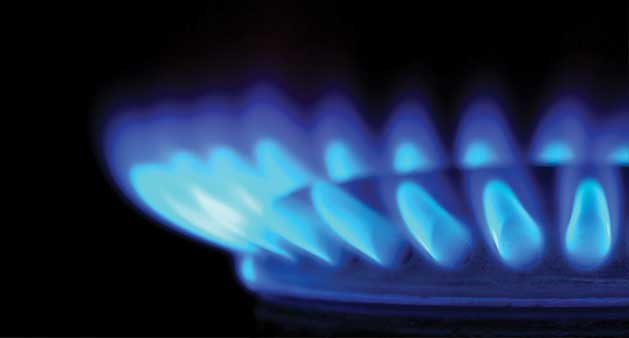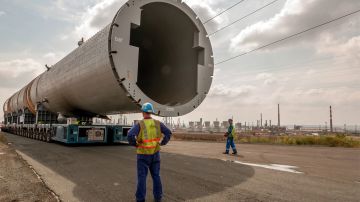Shale gas is burgeoning and with it so is American petrochemicals that use this new low-cost source of gas as its main raw material. Shale gas has changed the US energy market and is threatening to do the same for energy markets around the world. Production has soared from a meagre 1 to 2% of US output to nearly 25 percent since 2000 to a point where more than a quarter of the country’s total gas output now comes from shale gas. By 2035 the proportion could rise to around a half. As more shale gas is brought to the market prices have come crashing down relative to rising oil prices. Not long ago, America depended on imports of liquefied natural gas. Today it is on the verge of becoming a gas exporter. Vast “Shale” rock formations with very high hydrocarbon content have been known to exist for nearly a century from geological mapping and drilling for oil and gas across the US. These rock formations were considered to be too “tight” to release oil or gas until new techniques were developed. The techniques have also been known for a while. “Horizontal Directional Drilling” put in practice widely in the 1970s and 1980s and “Hydraulic Fracturing” or “Fracking” first put into practice in the 1950s. But it is only in the past decade that it has become economically and technologically viable, to apply these together and get at these new deposits,
“Horizontal Directional Drilling” allows the drilling of an oil/gas well horizontally in the rock “seam” for up to several miles. “Fracking” is the practice of blasting the rock layers underground to fracture the rock allowing high pressure sand, water and chemicals to be pumped into the fracture to allow the oil and gas to flow. In particular a unique feature of “Shale” is that it often produces more natural gas than oil and the natural gas produced is often “wet” with Natural Gas Liquids such as ethane and propane. These materials can be recovered from the gas as feedstock to petrochemical operations.
Because of the abundance of new wells and production brought on line recently, both natural gas and the gas- based feedstock from the natural gas have fallen in price relative to traditional oil prices and oil derived feedstock such as naphtha used more widely outside of the US. There is no doubt that shale gas has stimulated the petchem sector in the US in the last two years, as can be seen from the many announcements of new crackers. But at the moment it is mainly seen as a US phenomenon.
“INEOS is in a good position to benefit from the increased ethane production that comes from shale gas”, comments Dennis Seith, CEO of INEOS Olefins & Polymers USA. “As more product comes available we can access this valuable feedstocks. Our crackers are flexible enough to take these lighter, natural gas liquid feeds, and process them into our primary product ethylene. Shale formations across Texas, the upper Mid-west and in the North Eastern part of the US are being developed and along with low-cost natural gas it is generating substantial quantities of “Natural Gas Liquids”. These developments of lower cost supplies of feedstock present significant new opportunities for our existing facilities in the US. Earlier this year we announced that we are completing engineering studies to debottleneck ethylene capacity at Chocolate Bayou in Texas. Such an investment would add a further 115,000 tonnes/year. It would meet the needs of INEOS’ commitments to the US Gulf Coast merchant ethylene market, while supporting our high density polyethylene [HDPE] unit at its La Porte, Texas, complex.”
But “fracking” is not without its issues. Many fear that there is the potential to cause subsidence, geologic instability and contamination of groundwater. As such it has been banned in some US states and countries in Europe until better understood so that better regulations and controls can be developed.
“INEOS is not in the business of Exploration and Production of shale gas industry but we see the value in a safe, well managed, well regulated extraction that secures a valuable and sustainable energy resource for the nation and its downstream petrochemicals industries.” says Dennis Seith. “The extraction process is well understood and in our view, the natural gas industry in partnership with local and national governments should support ‘common sense’ regulation to ease public worries about potential issues from hydraulic fracturing and ensure that Safety, Health and Environmental concerns are the highest priority for this rapidly growing technology in the US”.
For now, the shale gas advantage belongs to the uS but for how long? In Europe gas prices are twice that of America. So it is no surprise that some European countries are keen to replicate America’s shale gas boom. But it is not quite as straightforward. Costs are higher in Europe because of difficult geology. There is also a lack of political will and higher population density across many European countries making it more difficult to develop the necessary infrastructure for recovery and transportation of gas. All of which mean that it will take some time for this to become a reality. Current views are that the issues will be sorted out and that it is more of a matter of “when” than “if” the “Shale Gale” as it has been dubbed reaches beyond the US.
As demands on energy around the world continue unabated, it is inevitable that shale gas will play an important role. Initial surveys indicate Poland has enormous reserves of shale gas, as much as 5.3 trillion cubic metres – equivalent to 300 years of their domestic consumption. PetroChina hopes to produce 1 billion cubic metres of shale gas in 2015 in SouthWest China. There has even been a recent discovery of shale gas deposits near Blackpool in the North West of England.
INEOS has already positioned itself in the debate and as availability of shale gas impacts our markets we are already making efficient use of this valuable resource in the US as it develops. Within Europe INEOS will be in position to accept strategic imports of low-cost ethylene into our new deep sea storage terminal in Antwerp when construction of the facility is complete. With the opening of one of the very few existing deep water terminals in Europe early next year we will be well placed to take full advantage, of lower cost ethylene imports resulting from access to shale gas from across the world.
















